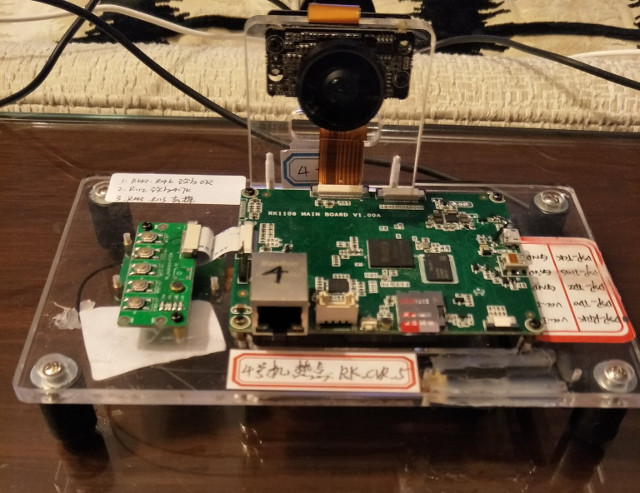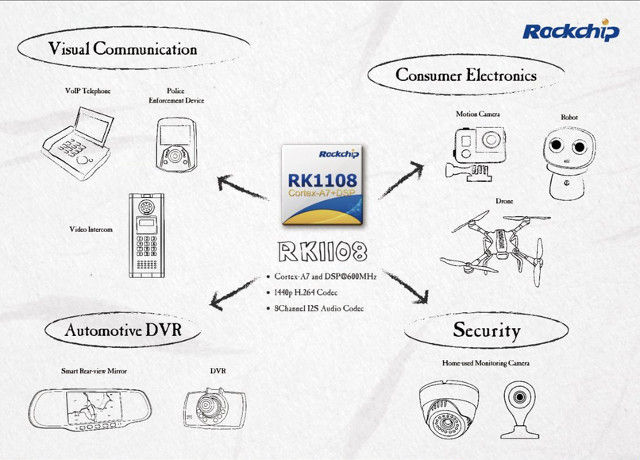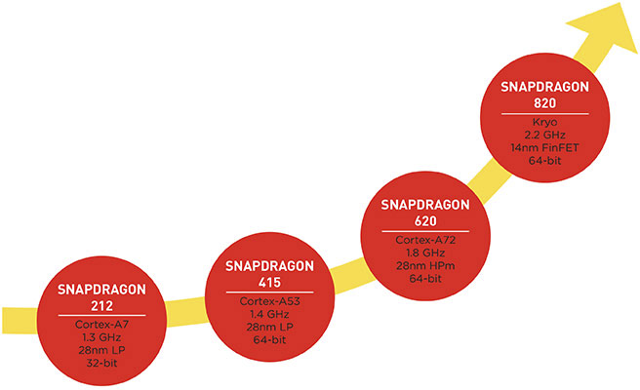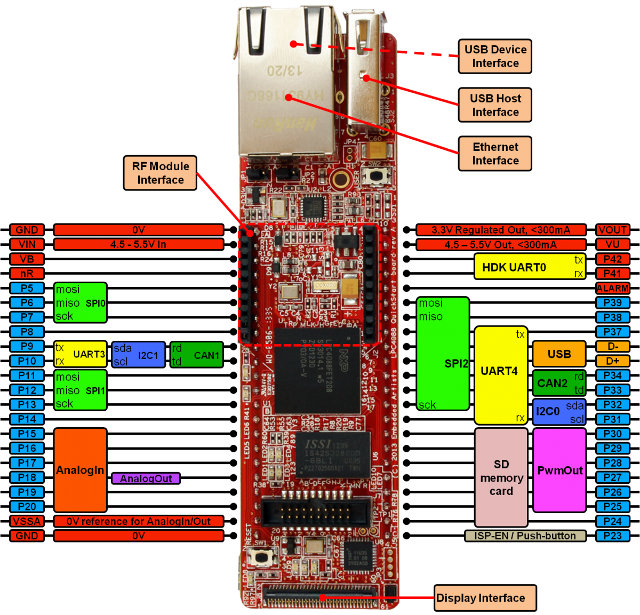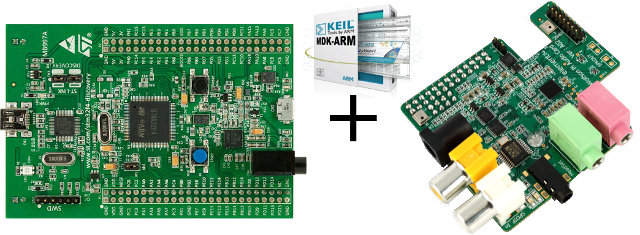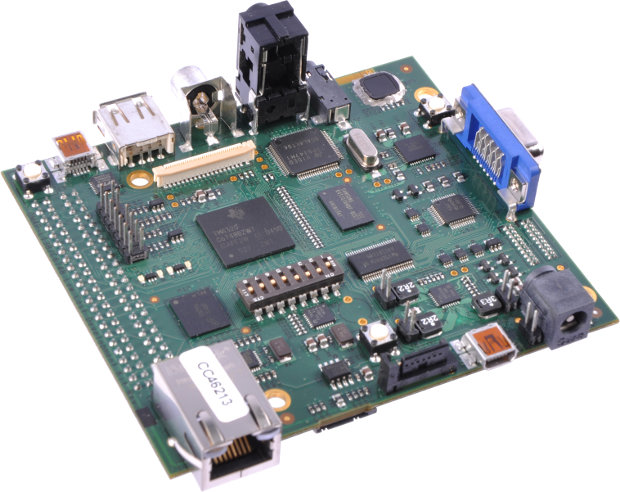Rockchip has joined other companies in developing camera SoCs with their RV1108 Visual Platform based on a single Cortex A7 core, a CEVA XM4 visual processing DSP, and capable of H.264 video encoding up to 1440p30 / 1080p60. Rockchip RV1108 main features and specifications: CPU – ARM Cortex A7 @ up to 1.0 GHz DSP – embedded CEVA XM4 vision processor up to 600MHz Video Encoder – 2K/H.264, high definition & low bit rate Camera – MIPI CSI and DVP interfaces Image processing – Low-light-level night vision imaging: 8MP professional image processing unit Audio Processing – Audio Codec supporting up to 8-way MIC array, 3A? phonetic algorithms, such as echo cancellation, noise suppression; Video Out/Input – HDMI OUT, CVBS OUT, MIPI DSI, CVBS IN Networking – 10/100 Ethernet PHY The processor is expected to be used in drones, IP cameras, car dashcams, sports/action cameras, as well as other applications such […]
Rockchip RV1108 Cortex A7 + DSP SoC is Made for Audio & Video Conference and Recording Applications
[Update May 2017: Rockchip has renamed RK1108 to RV1108.] Rockchip has introduced RV1108 ARM Cortex A7 SoC with a 600 MHz DSP targeting visual communication, consumer electronics, automotive DVR, and security applications thanks to its 8-channel I2S audio codec and 1440p H.264 video encoder and decoder. Detailed specifications can be found on the official Rockchip Wiki: CPU – Single-core ARM Cortex-A7 Core processor with NEON and FPU, 32KB/32KB L1 I-Cache/D-Cache, Unified 128KB L2 Cache, and Trustzone Video/Image DSP – Up to 600 MHz, 32KB I-TCM and 32KB I-cache, 128KB D-TCM Memory 12KB internal SRAM DDR3/DDR3L interface – 16 Bits data width, 1 ranks (chip selects), up to 512 MB RAM NAND Flash Interface – 8-bit async NAND flash, 16-bit hardware ECC eMMC Interface – Compatible with standard iNAND interface, eMMC 4.51 standard. SD/MMC Interface – Compatible with SD 3.0, MMC 4.41 System Component 2x 64-bit timers with interrupt-based operation 8x […]
Qualcomm Snapdragon 820 Promises Twice the Performance & Power Efficiency of Snapdragon 810
Qualcomm has provided more details about Snapdragon 820 processor featuring custom-designed 64-bit ARM Kryo cores, an Adreno 530 GPU and an Hexagan 680 DSP, with claims that it should be twice as fast and consume half the power of Snapdragon 810 processor with Cortex A57 and A53 cores. Based on the chart below, it will also be faster than Snapdragon 620 with Cortex A72 and A53 cores. Snapdragon 820 will feature four Kryo cores (succeeding Krait cores) clocked at up to 2.2 GHz and be manufactured using 14nm FinFET process technology. Adreno 530 GPU is expected to deliver over 40% performance improvement over Adreno 430 GPU while also keeping power consumption 40% lower, a new Spectra camera dual ISP will support 14-bit sensors, and Hexagon 680 DSP adds a separate low power DSP for always-on sensor processing, and support for HVX (Hexagon Vector eXtensions) to be used for advanced imaging […]
ARM Unveils Embedded Systems Education Kit Based on NXP LPC4088 Cortex M4 MCU
Following up on their first “Lab-In-a-Box” initiative based on Micro STM32F4-Discovery board and Wolfson audio card, ARM launched another low-cost toolkit, based on Embedded Artists LPC4088 QuickStart and Experiment boards, and called “Embedded Systems Education Kit”, to help university educators teach embedded systems design and programming concepts. The kit includes the following hardware, software tools, and teaching materials: Embedded Artists LPC4088 QuickStart Board and LPC4088 Experiment Base Board ARM Keil MDK-ARM Pro microcontroller development suite software licences Complete teaching materials including lecture note slides, demonstration code and hands-on lab manuals with solutions in source for four embedded system courses: ‘Efficient embedded systems design and programming’ teaches microcontroller fundamentals using NXP’s 32-bit ARM Cortex-M4 based LPC4088 microcontroller. ‘Rapid embedded system design and programming’ delivers embedded systems design training for the high-level ARM mbed API ‘OS design’ uses the royalty-free ARM Keil RTX RTOS to show how to design, program and optimize […]
ARM Introduces DSP ‘Lab-in-a-Box’ For Education Combining STMicro STM32F4-Discovery Board and Wolfson Audio Card
DSP (Digital Signal Processing) courses at University have traditionally used software simulation packages (Matlab), or hands-on labs using development kits costing around $300 per student. In order to reduce costs, ARM University program and their corporate partners have launched a DSP ‘Lab-in-a-Box’ so that university students can learn DSP and audio systems with hardware selling for about $50, or over 80% cheaper than previous educational hardware. A typical DSP Lab-in-a-Box (LiB) would come with: STMicroelectronics ARM Cortex-M4-based STM32F4 Discovery MCU board Wolfson Microelectronics and Farnell element14 Wolfson Audio Card. ARM Keil MDK-Professional development tool with a 1-year renewable software license. Teaching materials such as lecture slides, code samples, and hands-on lab manuals. STM32F4-Discovery board features an STM32F407VGT6 MCU (ARM Cortex-M4F core) with 1 MB Flash, and 192 KB RAM, sensors (motion and accelerometer), a digital microphone, and audio DAC, a micro USB connector, and various buttons and LEDs. The Wolfson […]
Google Announces LG Nexus 5 Smartphone with Android 4.4 KitKat
Google has partnered with LG and Nestle to bring to market the latest Nexus 5 smartphone featuring Android 4.4 “Kitkat”, the latest, and brand new, release of Android. Let’s first have a look at the device, and then we’ll go through the new features and improvement brought by Android 4.4. LG Nexus 5 Nexus 5 has the following technical specifications: SoC – Qualcomm Snapdragon 800 @ 2.26GHz with Adreno 330 GPU @ 450MHz System Memory – 2GB RAM Storage – 16 to 32 GB flash, but no microSD slot Display – 4.95″ touchscreen display with 1920×1080 resolution, Gorilla Glass 3 Connectivity – Dual band 802.11a/b/g/n/ac WiFi (2.4G/5G), Bluetooth 4.0, NFC, and GPS Celullar Networks – 2G/3G/4G LTE. GSM, CDMA, WCDMA, and LTE in North America, and GSM, WCDMA, and LTE for the rest of the world. Camera – 8MP rear camera with Optical Image Stabilization (OIS) and 1.3MP front camera […]
TI TMS320C6748 DSP Low Cost Development Kit for Fingerprint Recognition and Face Detection
Texas Instruments recently introduced the TMS320C6748 DSP development kit (LCDK) for real-time analytics applications such as fingerprint recognition and face detection, as well as other digital signal processing applications, such as audio and communications. The C6748 DSP development kit comes pre-loaded with TI C6748 SYS/BIOS Software Development Kit (SDK) which includes: SYS/BIOS real-time kernel C6748 StarterWare software package (lightweight, operating-system-independent software libraries and utilities) Sample apps for fingerprint recognition and face detection Code Generation Tools DSP core performance benchmarks that show the real-time processing power of TI’s C674x DSPs. The C6748 DSP development kit also includes Code Composer Studio IDE v5.1. Several standard interfaces for connectivity and storage are available in the board to allow audio, video and other signals. Expansion headers also allow developers to add display and user interface technology, such as camera boards and LCD screens. The board schematics and design files are supposedly available for download, […]
Linux 3.3 Release
Linux Torvalds announced the release of Linux Kernel 3.3 on the 18th of March: So after the extra -rc release last weekend, now the final 3.3 is out there in the usual locations. Things did indeed calm down during the last week, and the shortlog looks pretty boring. The diffstat from -rc7 is dominated by the arch/tile defconfig changes, the rest is pretty small, although there are changes spread out in various subsystems (drivers, filesystem, networking, perf tools). … And obviously, the 3.3 release means that the merge window for 3.4 is now open, although I may keep of pulling stuff for a day or so to encourage people to test the actual release. Linux 3.2 brought ext-4 and btrfs file system improvements, support for Qualcomm Hexagon processor, an improved profiling tool (perf top), and better CPU and network bandwidth management. Linux 3.3 brings the following key changes: Android merge: […]


